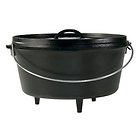Camp Ovens
 For those who enjoy camping and cooking outdoors, few implements are as indispensible as the heavy cast iron covered pots known as camp ovens. Alternately referred to as camp stoves or footed dutch ovens, these utilitarian cooking vessels were made to perform a variety of tasks and to last forever. With roots stretching back to early colonial settlers of this continent and elsewhere in the world, the versatility of camp ovens has kept them popular to the present day.
For those who enjoy camping and cooking outdoors, few implements are as indispensible as the heavy cast iron covered pots known as camp ovens. Alternately referred to as camp stoves or footed dutch ovens, these utilitarian cooking vessels were made to perform a variety of tasks and to last forever. With roots stretching back to early colonial settlers of this continent and elsewhere in the world, the versatility of camp ovens has kept them popular to the present day.
While similar, there are a few things which distinguish a camp oven from its household counterpart, the dutch oven. The most prominent difference between the two is the lid. While a dutch oven lid is domed and typically has drippers for self-basting, a camp oven's lid is thick, mostly flat, smooth-bottomed, and has a ridge around the top edge. The massive lid helps maximize heat retention. The ridge, a design innovation some attribute to Paul Revere, allows hot coals to be placed on top of the oven as well as below. In most cases, the lid can also be inverted for use as a griddle.
Like more primitive cast iron cookware, camp ovens typically have feet, which allow them to be used directly over a campfire. Coupled with the flat top lid, the feet also allow multiple camp ovens to be stacked over the same fire, maximizing heat source utilization.
While best suited to making hearty, one-pot dishes like stews, or braising large chunks of meat to fork tenderness, camp ovens also excel at producing baked goods such as biscuits and cornbread.
Like dutch ovens, camp ovens are made in a variety of sizes, and are usually either size numbered or designated by their diameter in inches. The numbering system used by various manufacturers seems somewhat arbitrary, with numbers appearing to be related in some cases to the diameter, and in others to capacity.
Regardless of numbering, there is a wide variety of shapes and sizes from which to choose, with ovens small to large, and both deep and shallow. Having multiple sizes available to the camp cook also facilitates the aforementioned stacking.
In lieu of placing or stacking directly on the hot coals, an iron tripod frame with a chain attached allows a camp oven to be hung suspended above a campfire by its bail handle. With lids designed with a loop or tab handle, special long tools made from wrought iron rod are often employed to remove and replace the heavy lid while hot.
Although traditionally dependent on a wood-fueled campfire for a heat source, modern camp cooks have come to rely on the usually consistent and predictable heat output provided by commercial hardwood briquettes such as those made by Kingsford. Rules of thumb exist for ratios of numbers of fully-lit briquettes to be placed beneath and on the lid of a camp oven according to its diameter in order to achieve reasonably reliable estimates of cooking temperature.
| Camp Oven Temperature Guide | |||||||
|---|---|---|---|---|---|---|---|
| CO Size | Distribution of | 325°F | 350°F | 375°F | 400°F | 425F° | 450°F |
| 8" | Briquettes Top/Bottom | 15 10/5 | 16 11/5 | 17 11/6 | 18 12/6 | 19 13/6 | 20 14/6 |
| 10" | Briquettes Top/Bottom | 19 13/6 | 21 14/7 | 23 16/7 | 25 17/8 | 27 18/9 | 29 19/10 |
| 12" | Briquettes Top/Bottom | 23 16/7 | 25 17/8 | 27 18/9 | 29 19/10 | 31 21/10 | 33 22/11 |
| 14" | Briquettes Top/Bottom | 30 20/10 | 32 21/11 | 34 22/12 | 36 24/12 | 38 25/13 | 40 26/14 |
If you don't have the above table handy or memorized, there is a quick way to approximate the coals necessary to achieve 350°F. Called the "+3/-3" method, you simply add 3 to the number of inches diameter of the camp oven and place that many fully-lit coals on top. Subtract 3 from the diameter number and place that many coals below the oven. A 12" diameter camp oven would therefore need 15 on top and 9 underneath to cook at 350°F.

 A gallery of camp ovens and accessories.
A gallery of camp ovens and accessories.






